【范文】高二英语模块五 Unit3语法教学案
高二英语模块五Unit3语法教学案
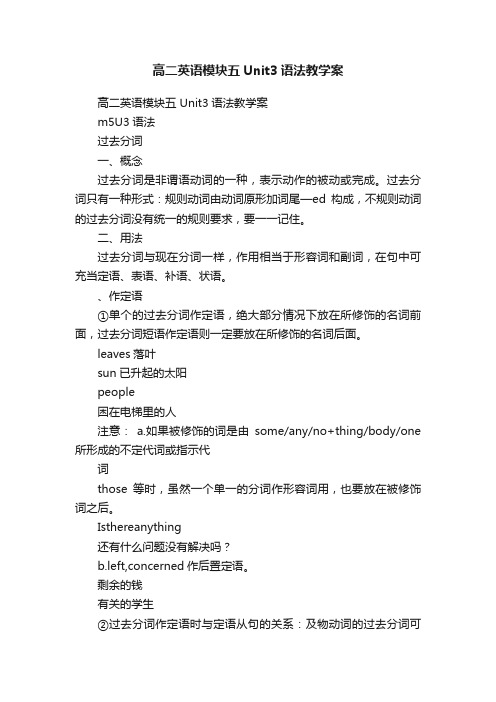
高二英语模块五Unit3语法教学案高二英语模块五 Unit3语法教学案m5U3语法过去分词一、概念过去分词是非谓语动词的一种,表示动作的被动或完成。
过去分词只有一种形式:规则动词由动词原形加词尾—ed构成,不规则动词的过去分词没有统一的规则要求,要一一记住。
二、用法过去分词与现在分词一样,作用相当于形容词和副词,在句中可充当定语、表语、补语、状语。
、作定语①单个的过去分词作定语,绝大部分情况下放在所修饰的名词前面,过去分词短语作定语则一定要放在所修饰的名词后面。
leaves落叶sun已升起的太阳people困在电梯里的人注意:a.如果被修饰的词是由some/any/no+thing/body/one 所形成的不定代词或指示代词those等时,虽然一个单一的分词作形容词用,也要放在被修饰词之后。
Isthereanything还有什么问题没有解决吗?b.left,concerned作后置定语。
剩余的钱有关的学生②过去分词作定语时与定语从句的关系:及物动词的过去分词可改为定语从句。
thetime=thetime失去的时间Thestudentishisdaughter.=Thestudentwhoishisdaughter.在考试中被抓住作弊的那个学生是他的女儿。
③一些过去分词转化的形容词修饰look,smile,voice,expression 等名词,表示人的情感。
Fromhisexpression,Iknowhehasn’tunderstoodit.2、作表语过去分词作表语时并无“完成”或“被动”之意,表示主语的感情或状态。
Ifeltathisbehavior.过去分词作表语不要与被动语态混为一体。
它们的主要区别是:被动语态表示主语所承受的动作,过去分词作表语表示主语的特点或所处的状态。
试比较:Thewindowisbroken.Thewindowwasbrokenbythatboy.3、作补足语过去分词可在某些动词如make,have,get,find,leave,keep,see,hear,notice,watch ,feel等动词或某些介词如with的宾语之后作宾语补足语。
译林牛津模块5Unit3学案(教师版)(译林牛津版高二英语必修五教学案例)

译林牛津模块5 Unit3学案(教师版)(译林牛津版高二英语必修五教学案例)Unit 3 Science versus nature (Part I)For the use of teachersI. Words:1. announcement n. 口头通知草拟书面通知 draw up a noticemake an announcement发(口头)通知 a TV announcer 电视播音员announce和declare的辨析:announce 宣布固定结构是announce sth. to sb.,不可以是announce sb. sth.;declare宣布(如公开声明战争/和平/中立等,较正式的场合),和announce有时可互换。
The Declaration of Independence 《独立宣言》The court declared him guilty / innocent.The teacher announced to us that there would be a celebration for the 80th anniversary of our school.The super power declared war against that small country in April, 2003.Everyone was silent as the chairperson announced/declared the results of the Spoken English Contest.2. advanced 高级的;先进的;发达的advanced countries/technologies/courses/studies与时俱进 advance with the times 高级教师 a senior teacherin advance 提前;预先同义词组:beforehand ;ahead of time make great advances 取得较大进步/进展同义词组:make great/rapid progress in3. including 用include或contain的正确形式试填下列各空:This book contains forty maps, including three maps of China.Whisky contains a large percentage of alcohol.He was upset about losing the key to the drawer containing important documents.In the air crash in Brazil, 197 people died, including the 9 on the ground/the 9 on the ground included.4. praise n./vt. 表扬;赞扬 praise sb. for sth. 反义词组: blame sb. for sth.; criticize sb. for sth.sing high praise for 高度赞扬同义词组: think well/highly of ; speak highly of等反义词组有:think little/nothing of; speak badly of 等The leader spoke in praise of the teacher who had given his life for the education cause.与in praise of 结构相同的短语有:in celebration/need/want/memory/honor/hopes of5. interfere vi. 干涉;干预;摆弄;妨碍固定搭配:interfere with sb./sth. interfere in sth.你曾经因为完乐而妨碍了你的职责吗?Do you ever allow pleasure to interfere with duty?Who has been interfering with the clock? It has stopped. 是谁摆弄这个钟来着?现在不走了。
高二英语外研版 必修5 Module 教案
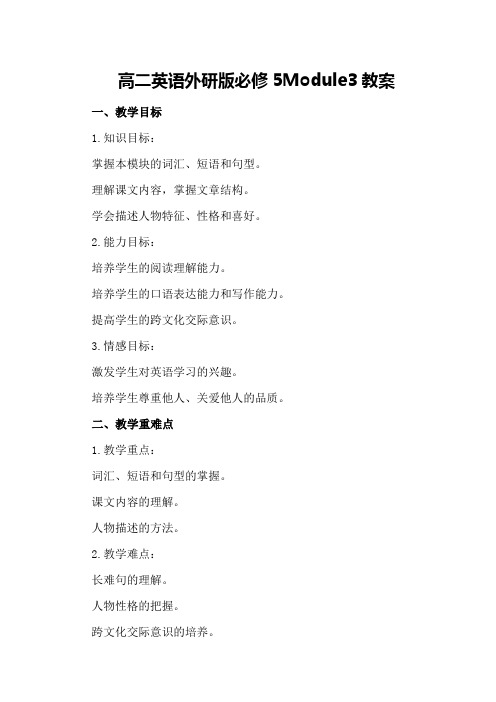
高二英语外研版必修5Module3教案一、教学目标1.知识目标:掌握本模块的词汇、短语和句型。
理解课文内容,掌握文章结构。
学会描述人物特征、性格和喜好。
2.能力目标:培养学生的阅读理解能力。
培养学生的口语表达能力和写作能力。
提高学生的跨文化交际意识。
3.情感目标:激发学生对英语学习的兴趣。
培养学生尊重他人、关爱他人的品质。
二、教学重难点1.教学重点:词汇、短语和句型的掌握。
课文内容的理解。
人物描述的方法。
2.教学难点:长难句的理解。
人物性格的把握。
跨文化交际意识的培养。
三、教学过程1.导入利用图片、视频或故事导入本模块的主题。
提问:你们对这个人有什么印象?他的性格特点是什么?2.词汇教学利用图片、实物或情境教授新词汇。
设计一些练习,让学生在语境中运用新词汇。
3.阅读教学让学生快速阅读课文,了解文章大意。
分析课文结构,找出文章的主题句。
对课文中的长难句进行讲解,帮助学生理解。
设计问题,让学生回答,检查他们对课文的理解。
4.口语教学设计一些角色扮演、讨论或采访活动,让学生在语境中运用所学知识。
教师示范,引导学生模仿。
5.写作教学提供一些写作素材,让学生进行写作练习。
分析优秀范文,让学生了解写作技巧。
批改学生作文,给出修改意见。
6.语法教学分析课文中的语法现象,让学生了解语法规则。
设计一些练习,让学生在语境中运用语法知识。
7.跨文化交际教学分析课文中的跨文化交际现象,让学生了解不同文化背景下的交际方式。
设计一些实践活动,让学生在模拟情境中运用跨文化交际知识。
8.课堂小结对学生的表现给予肯定和鼓励。
四、作业布置1.复习本节课的词汇、短语和句型。
2.完成课文后的练习。
3.准备下一次课的口语活动。
五、教学反思本节课通过多种教学活动,让学生在语境中学习英语,提高了他们的阅读理解能力、口语表达能力和写作能力。
但在教学过程中,仍有一些不足之处,如:1.部分学生对长难句的理解仍有困难,需要加强语法教学。
2.部分学生的口语表达能力较弱,需要加强口语练习。
高二英语必修五_Unit3_Grammar_优教教学设计

Unit3 Grammar 优教教学设计设计意图This is the last period of this unit, aiming to help students get a basic knowledge of the grammar in this unit. The emphasis of this period is mainly placed on the understanding and usage of the grammar. Therefore, the teacher should create a relatively real context to present enough sentences for students to draw a conclusion about the rule of the Past Participle as the adverbial and attribute. In the meantime the teacher should offer more opportunities to students to practice. Exercises designed ought to be simple and easy to operate, which should be connected with their daily life to make exercises easy to understand.教学目标1. Students master the basic usages of the Past Participle as the adverbial and attribute.2. Students learn to use the Past Participle as the adverbial and attribute in the real situation through self-study and practice.3. Get students to be interested in English study and enjoy the beauty of English.教学重点Enable students to master the usages of the Past Participle as the adverbial and attribute.教学难点Guide students to use the Past Participle as the adverbial and attribute in real situations.教学过程Step 1: Lead-in1/ 8(设计意图:通过课文句子导入新课,让学生体会过去分词的使用语境,同时带着问题进入课堂,激发学生兴趣。
外研版高中英语必修5教案Module 3 Grammar
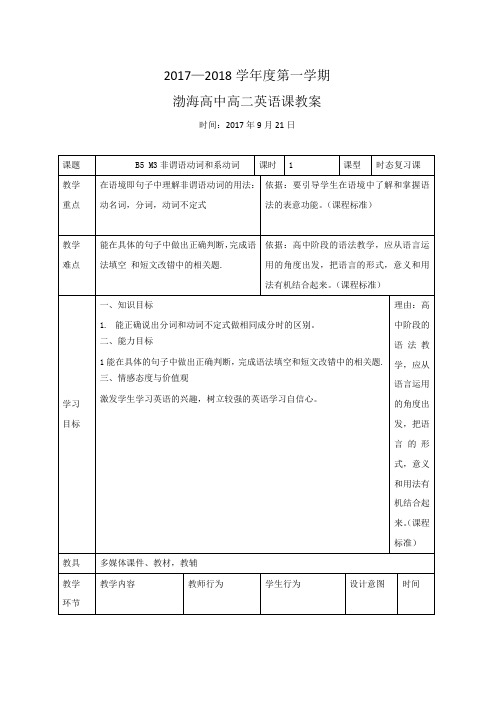
学习
目标
一、知识目标
1.能正确说出分词和动词不定式做相同成分时的区别。
二、能力目标
1能在具体的句子中做出正确判断,完成语法填空和短文改错中的相关题.
三、情感态度与价值观
激发学生学习英语的兴趣,树立较强的英语学习自信心。
检测学生自主学习情况,发现问题,解决问题。
10分钟
3.
做议讲评
1跟进巩固提升训练习题
1教师布置巩固提升习题,填空和改错
1全体学生独立完成巩固提升习题,小组讨论,小组展示,讨论,达成共识
进一步巩固训练,完成能力目标1,
15分钟
4.
总结提升
总结本课学习内容
教师鼓励学生总结本课内容,必要时补充
学生总结本课所学的知识点,包括现在完成时的基本用法,标志性时间状语,固定句型。
1或锻炼学生解读当堂学习目标2学生抢答教师提出的问题,回答正确可为小组加分。
调动学生自主预习英语的积极性,检测学生自主学习情况,完成知识目标1, ,
3分钟
2.
承接结果
核对自主学习任务中布置的习题答案。
教师监控学生展示讨论过程,必要时查缺补漏,适时补充。
一名学生展示自主作业习题,其他学生核对答案,提出质疑,讨论,最后达成共识。
2017—2018学年度第一学期
渤海高中高二英语课教案
时间:2017年9月21日
课题
B5 M3非谓语动词和系动词
课时
1
课型
时态复习课
教学
重点
在语境即句子中理解非谓语动词的用法:动名词,分词,动词不定式
依据:要引导学生在语境中了解和掌握语法的表意功能。(课程标准)
高二英语必修5模块3语法讲解教案

高二英语必修5 模块 3 语法讲解教案直接引语转换成间接引语的规则引述或转述别人的话称为“引语”。
直接引用别人的原话,叫作直接引语,用自己的语言转述别人的话,叫作间接引语。
直接引语用引号标出,而间接引语不需要引号。
直接引语为陈述句。
一般疑问句,特殊疑问句,和祈使句,转换成间接引语时,句子的结构,人称,时态,时间状语和地点状语都有变化。
1.人称的转变直接引语转化成间接引语时,人称要根据情况作必要的变化。
She said , “I am very sorry.”----- She said that she was very sorry.“ You should be more careful next time,” my father told me.---- My father told me that I should be more careful the next time.He said to his son, “I’ll check your homework tonight.”----- He said to his son that he would check his homework that night.2. 时态的转换直接引语改为间接引语时,主句的谓语动词如果是过去时,从句(即间接引语部分)的谓语动词在时态方面要作出相应的变化,变成过去时范畴的各种时态(实际也是宾语从句的时态要求)。
3.时间状语,地点状语及某些对比性的指示代词和动词的变化。
4.直接引语变成间接引语时,从句时态无须改变的情况。
1)直接引语表述的是客观事实。
科学真理和格言时,例如:The teacher said “ The earth moves round the sun.”---- The teacher said that the earth moves round the sun.He said, “ Practice makes perfect.”----- He said that practice makes perfect.2) 主句的时态是一般现在时、现在进行时或一般将来时时。
高二英语模块五 Unit3语言知识教学案
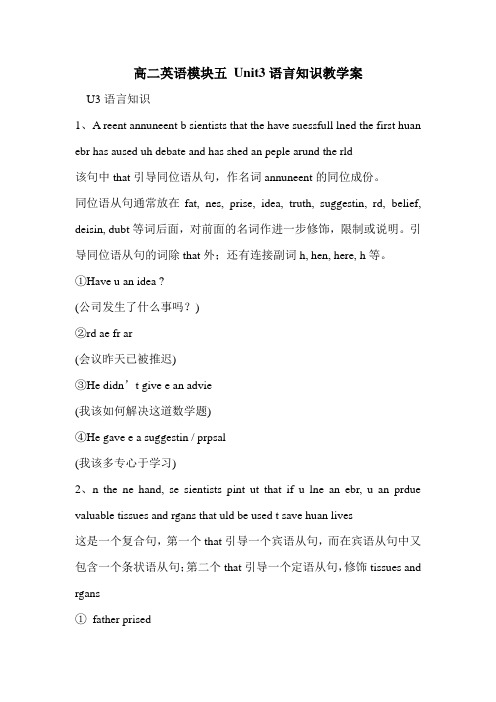
高二英语模块五Unit3语言知识教学案U3语言知识1、A reent annuneent b sientists that the have suessfull lned the first huan ebr has aused uh debate and has shed an peple arund the rld该句中that引导同位语从句,作名词annuneent的同位成份。
同位语从句通常放在fat, nes, prise, idea, truth, suggestin, rd, belief, deisin, dubt等词后面,对前面的名词作进一步修饰,限制或说明。
引导同位语从句的词除that外;还有连接副词h, hen, here, h等。
①Have u an idea ?(公司发生了什么事吗?)②rd ae fr ar(会议昨天已被推迟)③He didn’t give e an advie(我该如何解决这道数学题)④He gave e a suggestin / prpsal(我该多专心于学习)2、n the ne hand, se sientists pint ut that if u lne an ebr, u an prdue valuable tissues and rgans that uld be used t save huan lives这是一个复合句,第一个that引导一个宾语从句,而在宾语从句中又包含一个条状语从句;第二个that引导一个定语从句,修饰tissues and rgans①father prised(假如我通过考试,他会给我买一新自行车)②father ade a prise(假如我通过考试,他会给我买一新自行车)n (the) ne hand…n the ther hand…一方面……另一方面……前一个the可以省略,后一个the不能省略。
I ant t g n a trip n (the) ne hand I lie it ; (另一方面我有钱)英语中常用的表示列举的词汇还有:fr ne thing,…fr anther 首先…其次…first(l), … send(l) … 第一…第二…3、n the ther hand, an peple , inluding se sientists, disagree and fear that if anind interferes ith nature in this a, the a be n their a t prduing a real- life Franlin’s nstern ne’s/ the a t ding即将要做某事n ne’s a + n在……路上n the a + adv在……途中the a t d / f ding做……方法①He is n the a (即将成为一名优秀的老师)②H d u find the a the thin f (解决这个问题)?③Dn’t be angr , the are (在回家的路上)相关短语互译:in a a 挡路;碍事决不;决非顺便说一句in this/ that a b the ab a f ae ne’s a feel ne’s afight ne’s a push ne’s a lead the a迷路4、hile lning huan ebrs is illegal in an untries, se sientists are –alread pushing ahead ith researh s as t deliver a lned huan babhile引导一个让步状语从句,意思是“尽管”;s as t deliver=in rder t deliver… 动词不定式表目的。
模块5Unit3全单元语言点详备教学案(教师版)(译林牛津版高二英语必修五教案教学设计)

模块5 Unit 3 全单元语言点详备教学案(教师版)(译林牛津版高二英语必修五教案教学设计)1. Science is developing so fast that it is beyond our imagination.科学发展如此之快,以致于超出了我们的想像。
beyond prep. (表范围)越出(某事物)范围;超越:(表位置)在或向(某物)的远处:*beyond one’s power非某人能力所能及的*beyond praise 夸不胜夸的*be beyond sb. 使人无法想像/理解/做等①自行车没法修理了。
The bicycle is beyond repair.②We can’t see anything beyond the river because of the fog.由于有雾,河的那边我们什么也看不见。
③ The beauty of the West Lake in Hangzhou is _________ description.A. withB. inC. beyondD. onReading : The perfect copy1. A recent announcement by scientists that …announcement n. 宣告,通告*make an announcementannounce v.宣布; 宣告; 发表*announce sth. (to sb.)*announce (to sb.)that①She announced the winner of the competition to an excited audience.她向激动的观众宣布了比赛的冠军。
②宣布比赛什麽时候开始了吗?Have they announced when the race will begin?比较declare v. 正式宣布(某事); 表明:declare sth./that/ sb. (to be)① declare `war (on/against sb) 向… 宣战② declare the meeting open/closed 宣布会议开始/结束③ She was declared (to be) guilty. 已宣判她有罪.2. …has caused much debate and has shocked many people around the world.shock v [尤用於被动语态] 使(某人)震惊;*sth. shock sb.*sb. be shocked at/by sth./ to do*sth. be shocking 令人震惊的① He was quite shocked to hear the sho cking news.② 她所说的真的让我很震惊。
人教版高中英语必修5 Unit3 Grammar名师教学设计

(详见附后的教学设计)
教
学
评
价
1.本课时的目标设计清晰可操作,活动的设计紧扣目标要求并与目标达成一致;
2.语法课的活动环节设计遵循语法学习规律,自上而下逐层递进,注重培养学生归纳总结的能力;
3.语法课后的活动设计体现对情景中再现语法的教学策略,注重了对学生运用语法知识能力的培养。
Section 3语法课教学设计
教
学
目
标
语言目标:
1.学生能掌握过分词作定语和状语这一语法现象。
2.学生能准确找到过去分词的逻辑主语,并明确他们之间的被动关系。
语义目标:
1.学生能准确分析过去分词在句中充当的成分(作状语和定语)。
2.学生能熟记,过去分词的巧学口诀。
语用目标:
1.学生能正确理解过去分词作状语和定语的句子。
2.学生能在语境中正确地使用过去分词
步骤
过程
措施(教师活动与学生活动)
目的
持续性评价
DELC1
预备与激活先期知识
Step 1
Leading in(导入…
T: Today we will learn something about how to use the past participle as the adverbial and attribute. Let’s read the passage and underline the sentences which contains past participles.
情感目标:
1.学生能对语法学习变得更感兴趣;
2.学生能逐渐形成通过文本学习主动归纳语法现象的意识。
学习策略:
1.通过分析对比,发现语法现象;
模块5Unit3全单元语言点详备教学案(教师版)(译林牛津版高二英语必修五教案教学设计)3389
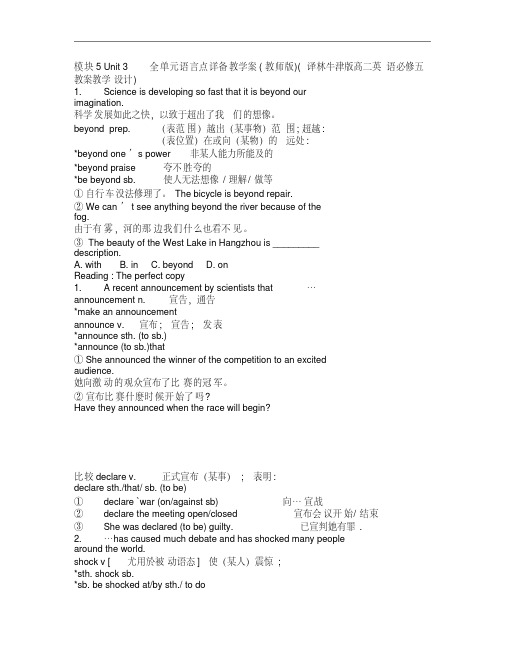
模块5 Unit 3 全单元语言点详备教学案(教师版)(译林牛津版高二英语必修五教案教学设计)1. Science is developing so fast that it is beyond ourimagination.科学发展如此之快,以致于超出了我们的想像。
beyond prep. (表范围)越出(某事物)范围;超越:(表位置)在或向(某物)的远处:*beyond one’s power非某人能力所能及的*beyond praise 夸不胜夸的*be beyond sb. 使人无法想像/理解/做等①自行车没法修理了。
The bicycle is beyond repair.②We can’t see anything beyond the river because of thefog.由于有雾,河的那边我们什么也看不见。
③ The beauty of the West Lake in Hangzhou is _________description.A. withB. inC. beyondD. onReading : The perfect copy1. A recent announcement by scientists that …announcement n. 宣告,通告*make an announcementannounce v.宣布; 宣告; 发表*announce sth. (to sb.)*announce (to sb.)that①She announced the winner of the competition to an excitedaudience.她向激动的观众宣布了比赛的冠军。
②宣布比赛什麽时候开始了吗?Have they announced when the race will begin?比较declare v. 正式宣布(某事); 表明:declare sth./that/ sb. (to be)①declare `war (on/against sb) 向… 宣战②declare the meeting open/closed 宣布会议开始/结束③She was declared (to be) guilty. 已宣判她有罪.2. …has caused much debate and has shocked many peoplearound the world.shock v [尤用於被动语态] 使(某人)震惊;*sth. shock sb.*sb. be shocked at/by sth./ to do*sth. be shocking 令人震惊的①He was quite shocked to hear the shocking news.②她所说的真的让我很震惊。
高中英语外研版必修五module3教案范文集锦

高中英语外研版必修五module3教案范文集锦编写教案的繁简,一般是有阅历的老师写得简略些,而新老师写得具体些。
原定教案,在上课进程中可依据详细状况做适当的必要的调整,课后随时记录教学效果,进行简要的自我分析,有助于积累教学阅历,不断提高教学质量。
以下是我带来的高中英语外研版必修五module3教案内容,感谢您的阅读,期望能帮忙到您!高中英语外研版必修五module3教案2高中英语外研版必修五module3教案5Teaching points: Grasp the important words and phrases.一、Warming up: 1. Greeting:T: Hello, boys and girls. Let us recite the seasons. Ok?Ss: Ok.T and Ss: spring, summer, autumn and winter.T: What day is it today?Ss: Today is ……2. Saying a chant:Hello, Meg, hello, Ted.What’s his name? He is Ben.What’s her name? She is Pat.How old is she? She is eight.How old is he? He is nine.3. Singing “Head, shoulders, knees and toes.二、New concept.T: Oh, you are great .Today let us learnModule 6ActivitiesUnit 1 What do you do at the weekend? (Writing and reading) 1. T: Do you like playing football?Ss: Yes, I do.T: What do you do at the weekend? (e-plain in Chinese ) Ss: I play basketball.T: I like reading at the weekend .What about you?Ss: I like swimming.T: You are great.T: And what do you have at school?You can say: I have ……Ss: I have English and Chinese.T: Do you like maths?Ss: Yes, I do. / (No, I don’t.)T: What do you do at 5 o’clock in the morning?I sleep in the morning. What about you?Ss: I sleep too.2. Do e-ercises: On the board write the following list1) What do you do at the weekend?I………..2) What do you have at school?I have …… and ……3. Listen and say. Play the tape, pause it after each utterance and let the Ss repeat the sentences.4. Show the Ss some books .For e-ample “Maths” “Chinese” “Science”Show the Ss some pictures “football” “sleep” “swimming5. Te-t 1) Listen and look.2) Answer questions:What do you do at ……o’clock i n the morning?What do you have at school?三、Homework: 1) Read the te-t frequently and recite the te-t.2) Copy the following sentences 2 times.What do you do at the weekend?What do you have at school?高中英语外研版必修五module3教案范文文档内容到此结束,欢迎大家下载、修改、丰富并分享给更多有需要的人。
模块5 Unit 3 Word power(译林牛津版高二英语必修五教案教学设计)整理

模块5 Unit 3 Word power(译林牛津版高二英语必修五教案教学设计)整理Teaching objects:1. learn prefix and suffix and learn to guess meanings based on prefix and suffix2. learn organs of the bodyTeaching procedures:I Prefixes and suffixesStep1 Lead-inPlease use the proper form of the words below to answer questions!able agree lead appear novel regular respect1. You can’t find your pen. What happened to your pen?2. You want to get the book on the top shelf, but you are not tall enough. Do you think you will be able to reach the book?3. The two groups don’t agree with each other. They argued fiercely. So what is the problem between them called?4. Many people respect Mr. Li and think he is a good man. He helps people out and is a good citizen and friend. So can you find a word todescribe him?5. Mr. Wang has published several books. He loves his job writing novels. So what is Mr. Wang’s occupation (职业)?6. You can’t find the order of the numbers in a group of members. So can you find a word to describe the order of the numbers?7. Some ads say that if you take their pills, you’ll be healthy, look younger, become smarter and sleep better. What can you say about these ads?Step2 Prefixes and suffixesSometimes you can guess what a word means by looking at its prefix or suffix. Look at the left-hand column of each table. Try to find some examples and work out the meanings.Prefix Example Meaninganti-dis-in-il-im-ir-pro-re-un-Suffix Example Meaning-able-ful-ist-less-ment-nessStep3 Practice1. Do you think we should protect nature? Complete what an environmentalist is saying below. Use the following words.disrespect hopeless illegal uncertain understandableI think cutting down trees should be made ________and tighter laws should be introduced. So many people are showing their _________ for nature; they don’t seem to care that they are destroying the environment.Sometimes I think we’re fighting a _________battle against people who just don’t listen. I know scientists have worked hard to achieve scientific breakthroughs but it’s ___________whether they’ll ever succeed totally. Although it’s _______________ that they want to advance technology, I think some things are best left the way they are.2. More practice about prefixes and suffixesⅡ Organs and the bodyStep4 Learn organs and the body through the pictureStep5 PracticeComplete the following passage using the names of the organs above:Think of the body like a school. At the top of the school is the headmaster, known as the (1) _______. This is the organ that controls the rest of the organs, just like the headmaster controls the school. After this comes the (2) ________. It is like a teacher. This organ passes the blood around the body so it can run well. This is similar to the knowledge a teacher gives to students. Next is the (3) _______, which is the student. This organ is the only one that can re-grow itself. It helps to clean the blood. This is like knowledge students get from teachers. Students always grow with newly found knowledge. The (4) _________are the organs of the body that use the oxygen we breathe. Think of the oxygen as the life you lead at school. The (5) ____________ is very useful as it stores the food we eat until we can digest it properly. This is similar to the learning process. We store the information until we need to use it. So this organ is like a notebook. The (6) ___________are the organs that remove waste products from the blood and produce urine.Step6 Homework1. Try to remember as many words and expressions about prefixes and suffixes.2. Keep the names of the organs in mind.文档内容到此结束,欢迎大家下载、修改、丰富并分享给更多有需要的人。
外研版高中英语必修五 Module3 Grammar教案-新版

Module3 Grammar教案Teaching objective aims: Review of verb formsTeaching methods: Practice with a summaryTeaching procedure:Step 1 Grammar Review of verb forms(非谓语动词)I. 非谓语动词:动词不当谓语的三种形式:动词的-ing形式、过去分词、动词不定式,充当成分,如:主语、表语、宾语、定语、状语、补语等。
II. 非谓语动词的几种形式:1. 动词的-ing形式2. 动词不定式3. 过去分词III. 关于非谓语动词需要注意以下几点:1. 非谓语动词作状语,其逻辑主语是句子的主语e.g. 1) In order to be admitted into the army, he takes a lot of exercise every day.2) Forced to leave his homeland, he had to go to America.3) Finding no way home, Tom went back.2. 非谓语动词作定语a. 不定式做定语表将来具体动作,不定式与它所修饰的名词在逻辑上必须具备以下条件之一:主谓关系;动(介)宾关系;同位关系:说明所修饰词的内容。
e.g1) He is the first man to fly the Atlantic alone.2) He has got lots of questions to ask.3)She has a good chance to go to college.b.过去分词作定语表被动、完成e.g. The experiment done in July proved the theory true.c.动词-ing形式作定语表主动、进行e.g. The man standing at the door is a new comer.=The man who is standing at the door is a new comer.3.不定式和-ing形式皆可作结果状语,但不定式表意想不到的结果, -ing形式表自然而然的结果。
高中英语Unit5ⅢGrammar--情态动词和过去将来时教学案

⾼中英语Unit5ⅢGrammar--情态动词和过去将来时教学案Section ⅢGrammar——情态动词和过去将来时⼀、复习情态动词情态动词表⽰说话⼈对某⼀动作或状态的态度。
初中阶段⼤家已经学习了⼀些情态动词,这⾥将对情态动词的特征、功能和⽤法进⾏总结。
[观察例句]1.Oliver believes that with a million-pound bank note a man could live a month in London.2.Young man,would you step inside a moment,please?3.May we ask what you're doing in this country and what your plans are?4.I can't say that I have any plans.5.Anyway,I didn't dare to try again.6.You mustn't worry about that.7.If you'll excuse me,I ought to be on my way.[归纳⽤法]1.情态动词的基本特征(1)在形式上,情态动词没有实义动词的各种变化,只有could,would,had to,might 等⼏个过去式,其他情态动词如must、ought to等的过去式皆与现在式同形。
(2)在意义上,⼤多数情态动词有多个意义,如can可以表达“能⼒;可能;许可”等。
(3)在⽤法上,情态动词与助动词⼀样,需后接动词原形,构成谓语动词。
2.情态动词的否定式及缩略形式情态动词否定式缩略形式情态动词否定式缩略形式can cannot/can notcan't shall shall not shan'tcould could not couldn't sould should not shouldn't may may not / will will not won'tmight mightnotmightn't would would not wouldn'tmust must not mustn't need need not needn'tdare dare not daren't ought to oughtnot tooughtn't to3.情态动词的主要表意功能英语中的情态动词虽然为数不多,但是要掌握好它们的⽤法并不容易。
高二上学期英语备课综合:Book 5 Unit3 grammar教学设计-
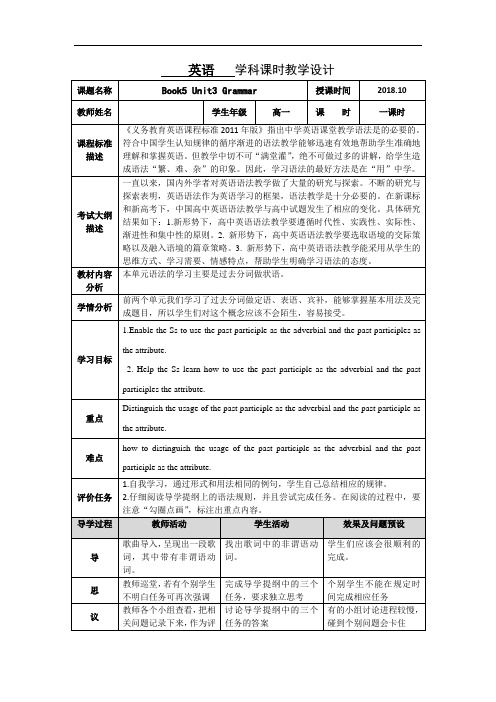
有的小组讨论进程较慢,碰到个别问题会卡住
展
教师给下面坐着的学生安排任务
各小组派代表上台展示三个任务的答案
有学生会坐在那里等展示同学的答案
评
对学生错误和教师认为的重点内容精讲
做笔记,并提出其它疑问
有学生会跟不上节奏
检
用单句填空和选择题的形式练习非谓语动词。
完成堂测堂检的题目,检测学生是否弄懂
导学过程
教师活动学Biblioteka 活动效果及问题预设导
歌曲导入,呈现出一段歌词,其中带有非谓语动词。
找出歌词中的非谓语动词。
学生们应该会很顺利的完成。
思
教师巡堂,若有个别学生不明白任务可再次强调
完成导学提纲中的三个任务,要求独立思考
个别学生不能在规定时间完成相应任务
议
教师各个小组查看,把相关问题记录下来,作为评讲时的重点
英语学科课时教学设计
课题名称
Book5 Unit3 Grammar
授课时间
2018.10
教师姓名
学生年级
高一
课时
一课时
课程标准描述
《义务教育英语课程标准2011年版》指出中学英语课堂教学语法是的必要的。符合中国学生认知规律的循序渐进的语法教学能够迅速有效地帮助学生准确地理解和掌握英语。但教学中切不可“满堂灌”,绝不可做过多的讲解,给学生造成语法“繁、难、杂”的印象。因此,学习语法的最好方法是在“用”中学。
2. Help the Ss learn how to use the past participle as the adverbial and the past participles the attribute.
高二英语必修五_Unit3_Grammar_优教学案

Unit3 Grammar 优教学案学习目标1. To master the basic usages of the Past Participle as the adverbial and attribute.2. To learn to use the Past Participle as the adverbial and attribute in the real situation through self-study and practice.3. To be interested in English study and enjoy the beauty of English.学习过程过去分词是非谓语动词的一种形式, 表示完成和被动的动作。
它在句子中可以充当状语、定语等成分。
Step 1:过去分词作状语1. When heated, ice will be changed into water. (过去分词作状语)2. Done in a hurry, his homework was full of mistakes. (过去分词作状语)3. Given more attention, the cabbages could have grown better. (过去分词作状语)4. The hunter left his house, followed by his dog. (过去分词作状语)【辨析】过去分词与现在分词作状语过去分词表、, 与主句主语之间是被动关系;现在分词表、, 与主句主语之间是主动关系。
如果一个被动的动作发生在谓语动词之前, 则可使用现在分词的完成被动式或过去分词。
Following the old man, we went upstairs. 跟着那个老人, 我们上楼了。
Followed by the old man, we went upstairs. 被那个老人跟着, 我们上楼了。
高二英语Book5 Unit3教学设计
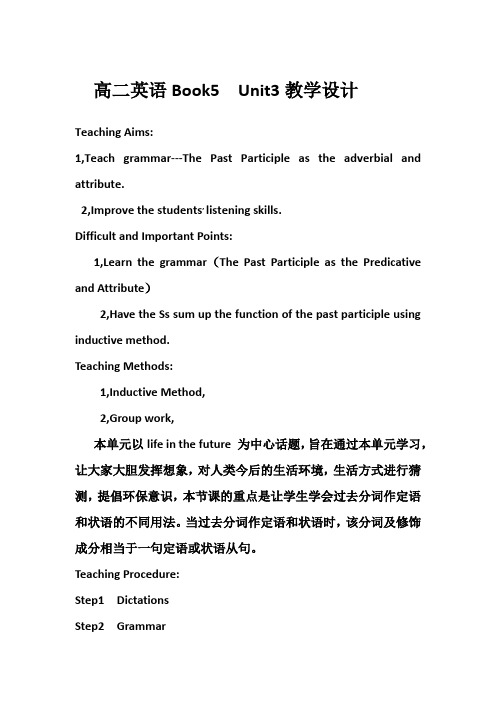
高二英语Book5 Unit3教学设计Teaching Aims:1,Teach grammar---The Past Participle as the adverbial and attribute.2,Improve the students, listening skills.Difficult and Important Points:1,Learn the grammar(The Past Participle as the Predicative and Attribute)2,Have the Ss sum up the function of the past participle using inductive method.Teaching Methods:1,Inductive Method,2,Group work,本单元以life in the future 为中心话题,旨在通过本单元学习,让大家大胆发挥想象,对人类今后的生活环境,生活方式进行猜测,提倡环保意识,本节课的重点是让学生学会过去分词作定语和状语的不同用法。
当过去分词作定语和状语时,该分词及修饰成分相当于一句定语或状语从句。
Teaching Procedure:Step1 DictationsStep2 GrammarPast participle used as adverbial and attribute一)Revision观察下面的句子,找出过去分词,并说出其在句子中的成分。
1,Polluted water is harmful to our health.2, He was inspired when he thought about helping people.3, I must get my bike repaired.二)探究发现一--------过去分词作状语的意义1,Worried about the journey,I was unsettled for the first few days.思考:上句中的过去分词短语在句中充当--------成分,它是连接两个句子的一种形式,此句子相当于原因状语从句。
- 1、下载文档前请自行甄别文档内容的完整性,平台不提供额外的编辑、内容补充、找答案等附加服务。
- 2、"仅部分预览"的文档,不可在线预览部分如存在完整性等问题,可反馈申请退款(可完整预览的文档不适用该条件!)。
- 3、如文档侵犯您的权益,请联系客服反馈,我们会尽快为您处理(人工客服工作时间:9:00-18:30)。
高二英语模块五 Unit3语法教学案m5U3语法过去分词一、概念过去分词是非谓语动词的一种,表示动作的被动或完成。
过去分词只有一种形式:规则动词由动词原形加词尾—ed构成,不规则动词的过去分词没有统一的规则要求,要一一记住。
二、用法过去分词与现在分词一样,作用相当于形容词和副词,在句中可充当定语、表语、补语、状语。
、作定语①单个的过去分词作定语,绝大部分情况下放在所修饰的名词前面,过去分词短语作定语则一定要放在所修饰的名词后面。
leaves落叶sun已升起的太阳people困在电梯里的人注意: a.如果被修饰的词是由some/any/no+thing/body/one所形成的不定代词或指示代词those等时,虽然一个单一的分词作形容词用,也要放在被修饰词之后。
Isthereanything?还有什么问题没有解决吗?b.left,concerned作后置定语。
剩余的钱有关的学生②过去分词作定语时与定语从句的关系:及物动词的过去分词可改为定语从句。
thetime=thetime失去的时间Thestudentishisdaughter.=Thestudentwhoishisdaughter.在考试中被抓住作弊的那个学生是他的女儿。
③一些过去分词转化的形容词修饰look,smile,voice,expression等名词,表示人的情感。
Fromhisexpression,Iknowhehasn’tunderstoodit.2、作表语过去分词作表语时并无“完成”或“被动”之意,表示主语的感情或状态。
Ifeltathisbehavior.过去分词作表语不要与被动语态混为一体。
它们的主要区别是:被动语态表示主语所承受的动作,过去分词作表语表示主语的特点或所处的状态。
试比较:Thewindowisbroken.Thewindowwasbrokenbythatboy.3、作补足语过去分词可在某些动词如make,have,get,find,leave,keep,see,hear,notice,watch ,feel等动词或某些介词如with的宾语之后作宾语补足语。
用来表示该动作的被动、完成。
Iheardthesongseveraltimeslastweek.上周我听见这首歌被唱了好几次。
withthework,theywentouttoplay.工作做完了,他们出去玩去了。
Pleasegetthereportassoonaspossible.请尽快把报告打出来。
4、作状语过去分词作状语表示被动的和完成的动作。
过去分词作状语可以表示时间、原因、方式或伴随、条件、让步等情况。
①表示时间,theparklooksverybeautiful.从山上看,这公园看起来很漂亮。
,thedictionarywillbeverypopular.一旦出版,这字典会很受欢迎。
②表示原因,hewasallwet.因为淋了一场大雨,他全身湿透了。
,hebecametheprideofhisparents.受到邻居们的表扬,他成为父母的骄傲。
③表示方式或伴随,theoldmanwentintotheroom.那位老人在他的妻子的搀扶下走进了房间。
Theteacherwalkedintotheclassroom,.老师走进教室,他的学生跟在后面。
④表示条件,wecoulddotheworkbetter.要是给更多的时间,我们会把工作做得更好。
,youshouldmakegreatereffortstostudyEnglish. 和你哥哥相比,你应该更加努力学习英语。
⑤表示让步,herefusedtobetrayhiscountry.虽然受到敌人的严刑拷打,他仍然不出卖国家。
,thefarmerswerestillworkinginthefields.尽管有风暴警告,农民们仍在地里干活。
注意:a.过去分词作状语时,逻辑主语一般与句子的主语一致,如不一致,必须加上逻辑主语,构成独立主格结构。
Allbooksreturnedattheendoftheterm,thelibraryassista ntwassatisfied.所有的书期末时都还了,图书管理员很高兴。
Theboyrushedintotheclassroom,.这男孩冲进教室,脸上全是汗。
b.当when,unless,once,if,whenever,though,although等连词引导的状语从句中的主语与主句的主语一致,且从句为被动语态时,从句可用省略形式,即“连接词+动词的过去分词”形式。
,hesaidnothing.当问到他时,他什么也没说。
,themedicinehasnosideeffects.如果按说明服用,这药没有副作用。
三、过去分词的否定式:not+过去分词Thehousewilllooksmallerif.如果这房子不刷成白色,就会显得小些。
,thetreesdied.没有得到好好的照顾,这些树死了。
,hefeltverydisappointed.没得到老师的表扬,他很失望。
四、一些过去分词短语单独作状语,如bornin…,dressedin…,lostin…,buriedin…,absorbedin…,preparedfor…等。
,hedidn’tnoticewhathadhappened.,shelooksmorebeautiful.,myfatherandIweretalkingaboutmyjob.Thepolicemanputdownthephone,withasmileonhisface.A.satisfiedB.satisfyingc.tobesatisfiedD.havingsatisfied语法随堂练习No.9一、短语翻译.一艘沉船2.一支点着的烟3.一个醉酒的人4.一次有组织的旅行5.发达国家6.发展中国家7.已升起的太阳8.正在升起的太阳9.一个叫james的人0.一个自称james的人二、用动词的适当形式填空.intoapoorfamily,theboyhasonlytwoyearsofschooling.2.withmanyothers,Englishweeklyisamorenewspaper.3.Theyounggirllefttheplace,nevertocomebackagain.4.Thenoiseofplanesislikelytocausedeafnessifcontinually.5.withhissister,hefeelsverylucky.6.Thelookonhisfacesuggestedthathehadn’texpectedthat.7.Theresultofthetestwasrather.Hewasveryatit.8.I’veneverheardthewordinspokenEnglish.9.Theyoftensawtheboybyhismaster.0.I’llhavethebookovertoyou.1.wheredidyougetyourwatch?2.Deeplyinmybook,Ididn’thearyouknock.三、选择1.inafriendlyway,theirquarrelcametoanend.A.BeingsettledB.Settledc.HavingsettledD.Settling2.oneoftheleadingpoetsinAmericatoday,Soniahasalsowrit tenanumberofnovelsandplays.A.consideringbeingB.consideredcHavingconsideredasD.Toconsider3.Itwasgettingdark;Ifoundacarinapoolbythesideoftheroad.A.tobestuckB.stuckc.stickingD.stick4.Thethieffelltotheground,hisleftfoot andblooddownfromhismouth.A.breaking,runningB.broken,runningc.breaking,runD.broken,run5.whenhecametohimself,hefoundhimself onachair,withhishandsback.A.tosit,tyingB.sitting,tyingc.seating,tiedD.seated,tied6.andhappy,Tonystoodupandacceptedtheprize.A.SurprisingB.Surprisedc.BeingsurprisedD.Tobesurprising7.youshouldunderstandthetrafficrulebynow.you’vehaditoftenenough.A.explainingB.toexplainc.explainD.explained8.inawhiteuniform,helooksmorelikeacookthanadoctor.A.DressedB.Todressc.DressingD.Havingdressed9.whenhelp,oneoftensays“Thankyou!”or“It’sverykindofyou!”A.offeringB.toofferc.tobeofferedD.offered10.moreattention,thetreescouldhavegrownbetter.A.GivenB.Togivec.GivingD.Havinggiven11.fromthemoon,ourearth,withwaterseventypercentofitssurface,appearsasa“blueball”.A.Seeing,coveringB.Seeing,coveredc.Seen,coveringD.Tosee,covered12.what’sthelanguageinGermany?A.speakingB.spokenc.bespokenD.tospoken13.Thespeakerraisedhisvoicebutstillcouldn’tmakehimself.A.hearB.tohearc.hearingD.heard14.TheolympicGames,in776Bc,didnotincludewomenplayersuntil1912.A.firstplayingB.tobefirstplayedc.firstplayedD.tobefirstplaying15.cleaningwomeninbigcitiesusuallyget bythehour.A.payB.payingc.paidD.topay16.Fromhislookonhisface,thepriceofmeatmusthaverisen.A.disappointedB.disappointingc.satisfiedD.satisfying17.inthought,healmostranintothecarinfrontofhim.A.LosingB.Havinglostc.LostD.Tolose18.mostoftheartiststothepartywerefromSouthAfrica.A.invitedB.toinvitec.beinginvitedD.hadbeeninvited19.Thecomputercenter,lastyear,isverypopularamongthestudentsinthisschool.A.openB.openingc.havingopenedD.opened20.Themanagersdiscussedtheplanthattheywouldliketose ethenextyear.A.carryoutB.carryingoutc.carriedoutD.tocarryout21.withadifficultsituation,Arnolddecidedtoaskhisbossfo radvice.A.TofaceB.Havingfacedc.FacedD.Facing22.—Howdoyoudealwiththedisagreementbetweenthecompanyand thecustomers?—Thekeytheproblemistomeetthedemandbythecustomers.A.tosolving,makingB.tosolving,madec.tosolve,makingD.tosolve,made23.Itshamesmetosayit,butItoldaliewhen atthemeetingbymyboss.A.questioningB.havingquestionedc.questionedD.tobequestioned24.Thepilotaskedallthepassengersonboardtoremain astheplanewasmakingalanding.A.seatB.seatingc.seatedD.tobeseating25.tosunlightfortoomuchtimewilldoharmtoone’sskin.A.ExposedB.Havingexposedc.BeingexposedD.Afterbeingexposed26.manytimes,buthestillcouldn’tunderstandit.A.HavingbeentoldB.Thoughhehadbeentoldc.Hewastold D.Havingtold。
